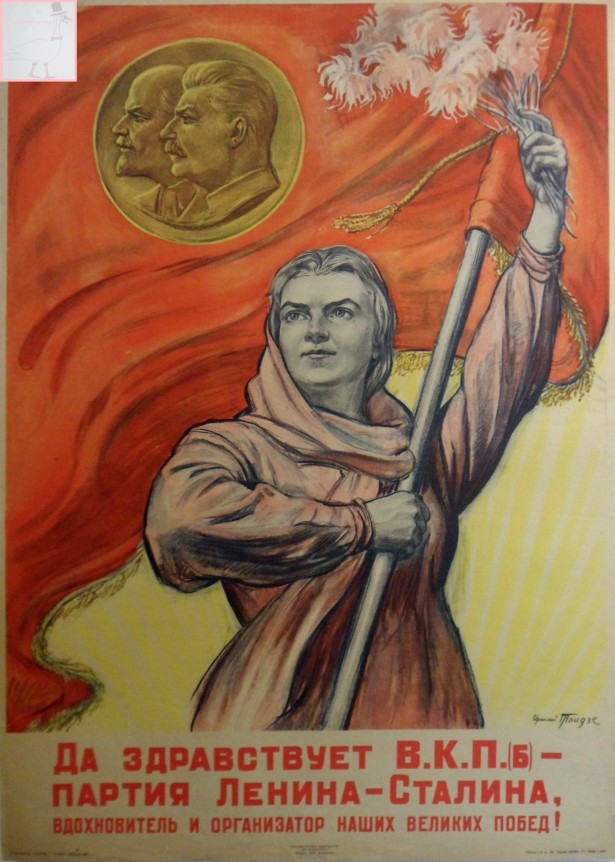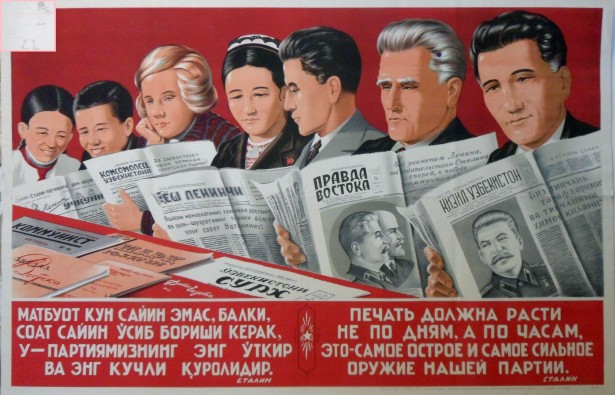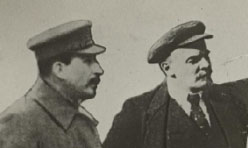
Iraklii Toidze (Тоидзе, И.), Long live the V.K.P.(b) – the party of Lenin-Stalin, inspirer and organiser of our great victories! (Да здравствует В.К.П.(б) – партия Ленина-Сталина, вдохновитель и организатор наших великих побед!, 1946
Stalin poster of the week is a weekly excursion into the fascinating world of propaganda posters of Iosif Stalin, leader of the USSR from 1929 until his death in 1953.
Here, Anita Pisch will showcase some of the most interesting Stalin posters, based on extensive research in the archives of the Russian State Library, and analyse what makes these images such successful propaganda.
Anita’s new, fully illustrated book, The personality cult of Stalin in Soviet posters, 1929 -1953, published by ANU Press, is available for free download here, and can also be purchased in hard copy from ANU Press.
This 1946 poster by Georgian-born Iraklii Toidze, produced the year after the end of the Great Patriotic War, credits the hyphenated Lenin-Stalin Party with the war victory.
Stalin’s victory in the war has made him worthy of co-identity with the great founding figure of Lenin, and Stalin takes equal place beside Lenin both visually and in the poster text. In fact, visually, Lenin is behind Stalin.
The poster is laden with sacred overtones.

The image of a strong but caring Motherland, the Rodina probably derives from the old Slavic goddess Mokosh
It is dominated by the figure of the Rodina, wielding a huge banner with the cameo images of Lenin and Stalin in profile enclosed in a gold medallion, and a bunch of flowers — symbol of fertility, abundance and celebration.
The Rodina is the embodiment of the Russian motherland, now expanded to include all the territories of the USSR. The Rodina probably derives from the old Slavic goddess Mokosh, who was the protective goddess of women, childbirth, weaving, spinning and sheep.
The Rodina in the poster is serene and maternal with an ample bosom and wide hips. She is also like the Virgin in the icon, her banner serving the same protective function as the Virgin’s veil, whilst also reconfiguring her as the mother of the revolutionary Bolshevik Party.
Behind the Rodina, the background consists purely of rays of light and the colour scheme, rich reds and golds, is reminiscent of the icon.

Lenin sits behind Stalin in a gold medallion that is both sacred and reminiscent of a war medal
The text at the base of the poster reads ‘Long live the V.K.P.(b) — the party of Lenin– Stalin, inspirer and organiser of our great victories!’
Anita Pisch‘s new book, The personality cult of Stalin in Soviet posters, 1929 – 1953, is now available for free download through ANU Press open access, or to purchase in hard copy for $83. This lavishly illustrated book, featuring reproductions of over 130 posters, examines the way in which Stalin’s image in posters, symbolising the Bolshevik Party, the USSR state, and Bolshevik values and ideology, was used to create legitimacy for the Bolshevik government, to mobilise the population to make great sacrifices in order to industrialise and collectivise rapidly, and later to win the war, and to foster the development of a new type of Soviet person in a new utopian world.
Visit Dr Anita Pisch’s website at www.anitapisch.com












